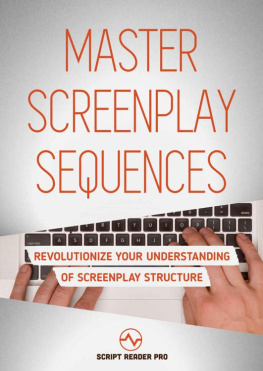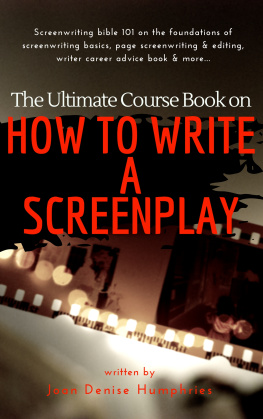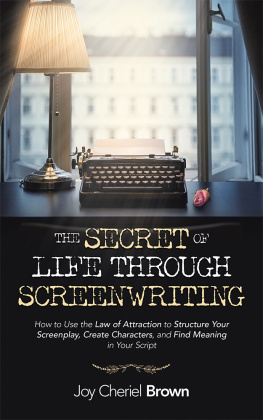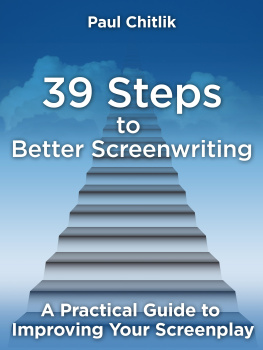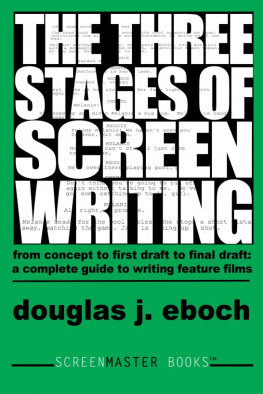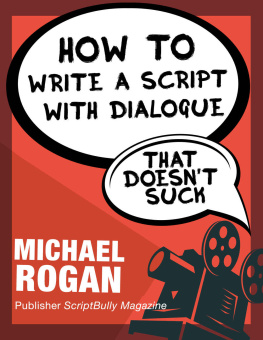Alex Bloom - Master Screenplay Sequences: The Ultimate Guide To Making Screenwriting Structure That Much Easier
Here you can read online Alex Bloom - Master Screenplay Sequences: The Ultimate Guide To Making Screenwriting Structure That Much Easier full text of the book (entire story) in english for free. Download pdf and epub, get meaning, cover and reviews about this ebook. year: 2016, publisher: Script Reader Pro, genre: Humor. Description of the work, (preface) as well as reviews are available. Best literature library LitArk.com created for fans of good reading and offers a wide selection of genres:
Romance novel
Science fiction
Adventure
Detective
Science
History
Home and family
Prose
Art
Politics
Computer
Non-fiction
Religion
Business
Children
Humor
Choose a favorite category and find really read worthwhile books. Enjoy immersion in the world of imagination, feel the emotions of the characters or learn something new for yourself, make an fascinating discovery.
- Book:Master Screenplay Sequences: The Ultimate Guide To Making Screenwriting Structure That Much Easier
- Author:
- Publisher:Script Reader Pro
- Genre:
- Year:2016
- Rating:3 / 5
- Favourites:Add to favourites
- Your mark:
- 60
- 1
- 2
- 3
- 4
- 5
Master Screenplay Sequences: The Ultimate Guide To Making Screenwriting Structure That Much Easier: summary, description and annotation
We offer to read an annotation, description, summary or preface (depends on what the author of the book "Master Screenplay Sequences: The Ultimate Guide To Making Screenwriting Structure That Much Easier" wrote himself). If you haven't found the necessary information about the book — write in the comments, we will try to find it.
Alex Bloom: author's other books
Who wrote Master Screenplay Sequences: The Ultimate Guide To Making Screenwriting Structure That Much Easier? Find out the surname, the name of the author of the book and a list of all author's works by series.
Master Screenplay Sequences: The Ultimate Guide To Making Screenwriting Structure That Much Easier — read online for free the complete book (whole text) full work
Below is the text of the book, divided by pages. System saving the place of the last page read, allows you to conveniently read the book "Master Screenplay Sequences: The Ultimate Guide To Making Screenwriting Structure That Much Easier" online for free, without having to search again every time where you left off. Put a bookmark, and you can go to the page where you finished reading at any time.
Font size:
Interval:
Bookmark:
 |  |


H ello, and thank you for purchasing our screenwriting book Master Sequences. As the title suggests, this book moves on from traditional structure theory to expose how screenplays are actually formed using plot points under the surface of the traditional three acts. By the end of this book you will see three act structure in a whole new light. You may ask what's wrong with the light it's already in? Vague notions of plot abound in the world of screenwriting: A screenplay is made up of three acts: Act Three, (set-up) Act Two, (development) and Act Three (climax). A catalyst has to occur around page twelve. At the Midpoint the stakes are raised, and so on. All well and good, but we think this approach is a little random. Free-floating, even. Maybe there's something else? Something going on under the broad strokes of three act structure that anchors the plot points and makes it easier to create continuous conflict in the protagonists journey? Well, there is... Sequences.
Maybe you already use sequences in your writing, but are still unaware of the intricacies involved in how they work? Or perhaps youve heard of sequences, but never used them before? In either case, this book is for you. Over the next seventy or so pages, we will equip you with the knowledge required to revolutionize your understanding of structure via sequences, making conflict easier to understand and, ultimately, easier to write.
 |  |


T raditional teaching about screenplay structure focuses on classic three act structure that goes something like this: Act One shows a protagonist getting called to a journey, Act Two tracks them going on the journey, and Act Three is the result of that journey generally coming back home with new lessons learned, and maybe a new relationship too. This structure, however, can be broken down into a much simpler form comprising of seven or eight sequences. (Although in some epics such as Lawrence of Arabia, there may be nine or ten.) These sequences underpin the existing three acts like this: two go in Act One, four in Act Two, and one (or two) in Act Three.
Heres how traditional three act structure looks when sequences are added:
ACT ONE: SEQUENCES A AND B
ACT TWO: SEQUENCES C, D, E, AND F
ACT THREE: SEQUENCES G AND H
Each of these sequences can be viewed as a mini movie with a specific goal for the protagonist and a resolution that takes him or her further or nearer to achieving the overall goal for the screenplay. Each sequence also has the same three act structure as the overall screenplay, with the climax to each equalling a major turning point in the screenplay.*
In five out of the seven or eight sequences, this major turning point is the same plot point as an act break. We give each sequence a letter, and break it down like this:
SEQUENCE A: CALL TO ACTION
SEQUENCE B: BIG EVENT DECISION
SEQUENCE C: DECISION SUCCESS/FAILURE
SEQUENCE D: MIDPOINT
SEQUENCE E: MIDPOINT SUCCESS/FAILURE
SEQUENCE F: ALL IS LOST/ALL IS JOY
SEQUENCE G: CLIMAX OR ALL IS LOST/ALL IS JOY SUCCESS/FAILURE
SEQUENCE H: DENOUEMENT OR CLIMAX
* This is where some of the confusion between seven and eight sequences arises when some people prefer to call the scene after the Climax a new sequence. True, the Climax is a major plot point, but the scene immediately after it is just the Denouement, and after that the credits roll so its not really a sequence in the true sense of the word.
ANATOMY OF A SEQUENCE
Just as in the overall film, the protagonists fortunes go from a positive to a negative (or vice-versa) from sequence to sequence as they traverse the screenplay. Its this back and forth motion of each sequence ending alternately on a positive or a negative that gives a screenplay its feel of a roller-coaster ride. For instance, Sequence E ends on a high point and is followed by a low point of Sequence F at the end of Act Two. This sets up the grand finale of Sequence G: a high point and the climax to the script.
Similarly, the protagonists fortunes change within the sequence itself, from a positive to a negative (or vice-versa), also helping to create a sense of motion and change. So, if the sequence begins on a high point Indiana Jones enters the Well of Souls having found the location of the ark, for example the chances are itll end on a low point: the Nazis steal the ark and lock him in the Well of Souls with Marion.

H OW SEQUENCES WORK WITHIN MOST FILMS
Sequence A
A screenplay often starts (but not always) with an Inciting Incident to get it rolling: either a major change in the protagonists life, such as just getting out of prison, or arriving in a new town, or an event unknown to them, such as a murder the detective is yet to hear about. Then, characters and world are introduced followed by a crisis around pages ten to fifteen. This is the heros Call to Action which sets into motion the main conflict for the overall screenplay and ends the sequence.
(In Romancing the Stone, Joan hears that her sister has been kidnapped. In Manhattan, Isaac meets Mary.)
Sequence B
The protagonist struggles to get to grips with the Call to Action crisis established at the end of Sequence A. But soon after theres another shock in store: a Big Event which signifies what theyre up against. This is what the films really about. The main conflict theyll have to tackle. From this they must make a Big Decision to embark on a new and potentially life-changing adventure. When they make this Decision we know theyre committed to solving the crisis established at the Call to Action and Big Event, and this signals the end of Act One.
(Neo takes the red pill in The Matrix and enters the real world. In American Pie, the guys make a pact to lose their virginity.)
Sequence C
The start of the strange and often scary new world in which the protagonist is often a fish out of water. This sequence contains, what Blake Snyder calls, The Promise of the Premise: the trailer moments in which the hero struggles to adapt to the new world. Note that the end of this sequence doesnt determine the end of an act, but is still a definite step forward or backwards in the protagonists main goal established at the end of Act One.
(Truman gets stuck on the bus and fails to leave the island in The Truman Show. Tor is humiliated by rival cheerleaders, The Clovers, in Bring It On.)
Sequence D
Having failed or succeeded at the end of the last sequence, the protagonist pushes on, invariably trying a different tactic in order to achieve their overall goal. The end of this sequence ends on either an up or a down and signals the scripts Midpoint usually a surprising twist of some kind. Here, the protagonist feels the full power of the antagonist but, conversely, is now fully committed to the goal, or a new variation of the goal. The stakes are raised as the protagonist turns a corner and a new self is born.
Font size:
Interval:
Bookmark:
Similar books «Master Screenplay Sequences: The Ultimate Guide To Making Screenwriting Structure That Much Easier»
Look at similar books to Master Screenplay Sequences: The Ultimate Guide To Making Screenwriting Structure That Much Easier. We have selected literature similar in name and meaning in the hope of providing readers with more options to find new, interesting, not yet read works.
Discussion, reviews of the book Master Screenplay Sequences: The Ultimate Guide To Making Screenwriting Structure That Much Easier and just readers' own opinions. Leave your comments, write what you think about the work, its meaning or the main characters. Specify what exactly you liked and what you didn't like, and why you think so.

